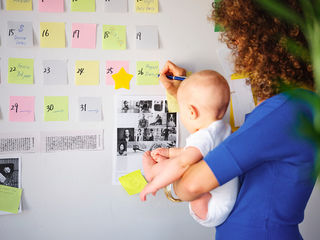ADHD
ADHD Moms: 5 Strategies to Feels Calmer Now!
Here are five simple strategies to help you feel calmer.
Posted March 3, 2020

ADHD Moms: 5 Top Tips to Feel Calmer
Do you have ADHD and feel overwhelmed with trying to balance working and being a mom?
When you get home from work, are you immediately ambushed by your children?
Are your mornings chaotic and stressful?
Many of my patients with Adult ADHD are also moms. Being a mom requires focus, organization, planning ahead, multitasking, and frustration tolerance. All of these present challenges for parents with ADHD.
Take Sandra* for instance. She is a 40-year-old married woman and a mom. She has three children and works in the real estate field. For many years, she worked very hard just to keep up. However, having ADHD and being a mom just tipped the scales. She was diagnosed with ADHD and anxiety in her early 20’s and currently takes Ritalin and Zoloft to manage these conditions.
Still, Sandra feels like her life is out of control these days. She feels frazzled in the morning trying to get herself ready for work and her children ready for school. And, when she comes home from work, she rushes to prepare dinner at the last minute. Even though her husband is very involved with household duties and parenting, Sandra feels as though she is drowning.
Recently, Sandra visited her primary care doctor for an annual exam. Upon hearing about Sandra’s challenges with juggling responsibilities, her doctor referred her to me for ADHD therapy using cognitive behavioral therapy, CBT. In addition to therapy, I recommend several day-to-day techniques to practice at home if you are a parent who identifies with Sandra’s situation.
Here are five strategies that many of my patients who have ADHD and who are parents have found helpful.
-
Create a Family Calendar and ADHD Moms. Create or purchase a large monthly calendar and place it in the kitchen where everyone can see it. Place all of the activities and events for the family on the calendar, as well as in your personal calendar. This will help keep everyone on the same page.
-
Create a Chore Chart and ADHD Moms. Weekly chores help the children feel part of the family and creates structure to help you keep the house in order. Depending on the children’s ages, some of the chores may include cleaning the table, washing the dishes, taking out the trash, and walking the dog. In addition to lifting some of the burden on your shoulders, this can free up time to employ necessary coping strategies and minimize stress.
-
Establish Household Rules and ADHD Moms. When creating household rules, it can be effective to have the entire family participate. This helps each person feel a sense of ownership. The rules will vary from family to family and the ages of the children. Rules may include expectations on how to treat each other, bedtime, homework, screen time, and housekeeping responsibilities. Review rules as often as needed.
-
Organize Children’s Keepsakes. As you know, having ADHD can lead to having piles and piles of papers around the house. School-aged children tend to make a significant contribution to the clutter. Create an organization system for each child. I recommend that you designate a file box for each child, divided by school year with separate folders for artwork, awards, and grades. Also, have a plastic storage box for each child’s keepsakes. Make sure to label the year and any other significant information. Finally, create a shelf or display for each child’s room for trophies and other important memorabilia. All these steps can help keep piles and anxiety from building.
-
Plan Meals. Instead of racing to throw meals together after a grueling day at work, draw out a game plan for the week. What needs to be chopped, thawed, peeled, or picked up from the supermarket? Delegate meal preparation tasks to family members who may arrive home first, or use weekends to pre-prepare dinner ingredients. Rate potential dishes on how easily they can be made; on longer days, you can fall back on your “easy” meals of spaghetti or store-roasted chicken.
- Make Time to Recharge for Mom. It is important for every parent to recharge. Schedule with your partner times that each of you can take a break from the family and do something for yourself, whether it is exercise, spending time with friends, or some other pleasurable activity. Make sure that you don’t neglect your relationship; set aside time to spend together without the children. Parenting is a full-time job without weekends, so even just a few minutes to quietly read a book or an hour at the gym can be beneficial.
Sandra and I worked together for three months. During our initial meeting, we developed therapy goals for her ideal work and home life. At each session, we discussed one of the challenges she faced and developed a strategy to help her move forward.
She began using a family calendar for every family member’s activities and events. We discussed the elements of a chore chart that she discussed with her family. The children were initially were hesitant, but after a few weeks, they began to enjoy being more engaged with the family and took pride in achieving their rewards. The strategy Sandra enjoyed the most was making time for herself. She and her husband agreed to keep one night free to spend time with her friends and Sunday morning to workout.
Ultimately, Sandra was less overwhelmed and more confident in her ability to deal with the daily bustle of a working mom. There was less chaos in the house and many more opportunities for pleasant family time. As you begin to employ these strategies to create a calmer home, remember to forgive yourself on days when nothing seems to work. Success doesn’t look like perfection; it looks like persistence. So, parents, persist.
*Disclaimer: Details of cases have been altered to protect the confidentiality of any and all individuals.


